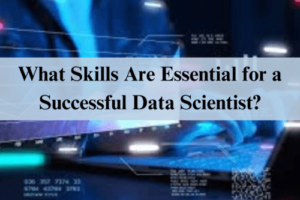

To extract useful insights from data, the multidisciplinary area of data science integrates computer science, statistics, and domain experience. As the demand for data scientists grows across businesses, recognizing the basic skills required for success in this field becomes increasingly important. Here’s a detailed look at the abilities required to succeed as a data scientist.
1. Strong Analytical and Statistical Skills
Understanding Data
A successful data scientist must be adept at understanding and interpreting data. This involves knowing how to collect, clean, and preprocess data. Familiarity with concepts such as data types, data structures, and data storage is crucial.
Statistical Analysis
Statistics form the backbone of data science. Key statistical skills include:
- Descriptive Statistics: Understanding measures of central tendency (mean, median, mode) and measures of dispersion (variance, standard deviation).
- Inferential Statistics: Conducting hypothesis testing, confidence intervals, and regression analysis to make predictions and infer trends from data.
2. Proficiency in Programming
Programming Languages
Proficiency in programming languages is essential for implementing data science techniques. The two most commonly used languages are:
- Python: Known for its simplicity and readability, Python has a rich ecosystem of libraries such as NumPy, pandas, scikit-learn, TensorFlow, and Keras that facilitate data manipulation, analysis, and machine learning.
- R: R is widely used for statistical analysis and visualization, with packages like dplyr, ggplot2, and caret being particularly useful.
Data Manipulation and Analysis
Understanding how to manipulate and analyze data using these programming languages is critical. This includes skills such as:
- Data Cleaning: Handling missing values, removing duplicates, and correcting data types.
- Data Transformation: Normalizing, scaling, and encoding variables to prepare data for analysis.
3. Machine Learning and Modeling
Supervised Learning
Supervised learning involves training models on labeled data. Essential algorithms include:
- Linear Regression: For predicting continuous outcomes.
- Logistic Regression: For binary classification tasks.
- Decision Trees and Random Forests: For both classification and regression problems.
- Support Vector Machines (SVM): For classification tasks.
- Neural Networks: For deep learning applications.
Unsupervised Learning
Unsupervised learning deals with unlabeled data. Key techniques include:
- Clustering: Grouping data points into clusters using algorithms like K-Means and Hierarchical Clustering.
- Dimensionality Reduction: Reducing the number of variables using methods like Principal Component Analysis (PCA) and t-Distributed Stochastic Neighbor Embedding (t-SNE).
Model Evaluation and Validation
A successful data scientist must be skilled in evaluating and validating models to ensure their reliability and accuracy. This involves techniques such as:
- Cross-Validation: Splitting the dataset into training and testing sets to evaluate model performance.
- Metrics: Understanding and applying evaluation metrics like accuracy, precision, recall, F1-score, and ROC-AUC.
4. Data Visualization
Tools and Techniques
Data visualization is crucial for communicating findings effectively. Essential tools and techniques include:
- Matplotlib and Seaborn: Python libraries for creating static, animated, and interactive visualizations.
- ggplot2: An R package for creating complex and multi-layered visualizations.
- Tableau and Power BI: Tools for creating interactive dashboards and reports.
Creating Effective Visualizations
A successful data scientist must know how to create clear and informative visualizations. This involves understanding the audience, choosing the right type of visualization, and emphasizing key insights.
5. Domain Expertise
Understanding the Business Context
Domain expertise allows data scientists to frame problems effectively and understand the context of the data they are working with. This involves:
- Identifying Business Problems: Understanding the business goals and translating them into data science problems.
- Interpreting Results: Making sense of the results in the context of the business and providing actionable insights.
6. Communication Skills
Presenting Insights
Data scientists must be able to communicate their findings clearly to stakeholders. This involves:
- Storytelling: Presenting data in a way that tells a compelling story.
- Reporting: Creating comprehensive and understandable reports and dashboards.
Collaboration
Collaboration with other teams, such as engineering, marketing, and product development, is often necessary. Effective communication ensures that data-driven insights are implemented correctly.
7. Continuous Learning
Keeping Up with Trends
The field of data science is rapidly evolving. Successful data scientists must stay updated with the latest tools, techniques, and trends by:
- Reading Research Papers: Following leading journals and conferences.
- Engaging with the Community: Participating in forums, attending meetups, and contributing to open-source projects.
Conclusion
Becoming a successful data scientist requires a blend of analytical skills, programming expertise, machine learning knowledge, data visualization capabilities, domain expertise, and strong communication skills. By continuously learning and adapting to new technologies and methodologies, data scientists can remain at the forefront of this dynamic and impactful field. Enrolling in a Data Science course in Delhi, Noida, Mumbai, Pune and other cities in India can provide a comprehensive foundation in these essential skills. Embrace these skills, and you will be well on your way to a successful career in data science.







